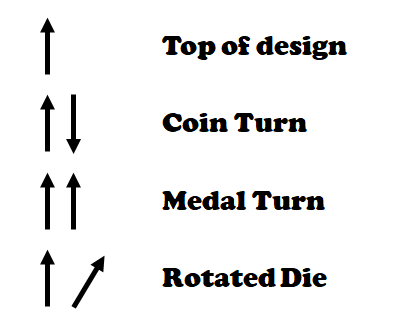
PREV ARTICLE
NEXT ARTICLE
FULL ISSUE
PREV FULL ISSUE
VOCABULARY TERMS: DIE ALIGNMENT, ROTATED DIEDick Johnson submitted these entries from his Encyclopedia of Coin and Medal Terminology. Thanks! These are especially important terms for collectors to understand.
-Editor
Two terms are included this week for their close relationship. Rotated Die coins are the result of Die Alignment (or chattering). Both are described by numismatists using shorthand symbols shown in the chart. Die Alignment. Positioning or orienting a pair of dies – obverse and reverse – so the axis of each matches perfectly. Dies cut on round DIESTOCK have the ability of being rotated, and thus need to be oriented during SETUP. Pieces struck from dies at this time, DIE TRIALS, may show a perfect ALIGNMENT, or more often, show an axial misalignment until they are correctly positioned. A struck piece with an imperfect alignment is called a ROTATED DIE.
Keying dies for alignment. On die alignment of very critical register some form of keying is employed. This can be as simple as drawing, scribing, or painting a line – GUIDE MARK – on the side of both dies. Dies are placed in the press where these lines can be observed and are locked in their chucks so the two dies are lined up exactly. Pieces struck at this time should have the desired die alignment. For OPEN FACE DIES a very exacting form of keying can be employed: GUIDE PIN AND BUSHING. A hole is drilled in the face of both dies (outside the image, of course) directly across from each other; a guide pin is inserted in one and when the dies are mated the pin should enter the bushing lining the hole on opposite die for critical register. During striking the guide pin can remain (if not in the way of feeding the blanks) or be removed. Dies cut on square or hexagonal diestock usually do not need a critical register for both dies as the alignment is left up to the diemaker to cut the die precisely square with one side of the diestock (the pressman can easily obtain die alignment during SETUP by manually positioning the square or hexagonal diestock, but could, conceivably be 90°, 180° or 270° off alignment for square stock). Rotated misalignment. Where struck pieces show rotated misalignment, particularly in the coining process with dies on round diestock, this is a result of: (1) incorrect setup, a human error of ineptness or malfeasance; or (2) loose dies, which may cause a CHATTERING of the dies, which will eventually cause a struck piece with rotated dies. The later is a mechanical error, no matter how tight the dies are locked in their chucks, some vibration may loosen these causing the dies to rotate. Coins with the alignment of opposite arrows– called the 6 o’clock position – usually have the most common misalignment at the 12 o’clock position (two arrows pointed up), undoubtedly due to incorrect setup, followed by 5 o’clock and 7 o’clock, slight rotating from the standard position, other positions follow with 11 o’clock and 1 o’clock the rarest positions of all (there are exceptions, of course). Die Alignment of United States coins. Coins exhibiting misalignment due to any of the above causes exist in every decade of United States coining. It is not peculiar to one mint or the size of the dies and coins, nor to the kind of composition. Coins out of alignment can occur during any coinage with dies made of round diestock. While coins from large press runs may be apt to have dies working loose, even this is not exclusively a reason for their existence. Numismatic cataloger Walter Breen mentions only 18 U.S. coins with incorrect die alignment in his encyclopedia of U.S. coins. Most of these were for important coins (like the Confederate half dollar, Breen 8001). He completely omits mention of any Lincoln cent misalignment, yet these are so common, special collections can be made of these. Breen does relate, however, that 1983 Olympic Dollars of 1983-S in proof rotated 180° were caught and destroyed by mint officials before they were issued. Some collectors make a study of rotated dies; while not that important an aspect of numismatics, it is an interesting bypath of numismatic study. References: CLASS 06.4 Rotated Die. A striking error in which the axis of the reverse does not agree with that of the obverse. A rotated die is due to one of two causes: 1) misalignment during setup (see DIE ALIGNMENT), or 2) CHATTERING in which the dies are not secure in their chucks and turn, or rotate, during constant striking. The amount of rotation is expressed in degrees of a circle: coins (with the top of obverse to the bottom of the reverse) is 0° normal. Rotation is also expressed in clock face positions from 1 to 12, each number being 30°, as 3 o’clock is 90° off center. It is never known by observing the struck piece which die has rotated, obverse or reverse. In describing rotated die coins, we assign the obverse as the standard, it would always be the reverse that is rotated (even though this may not have been the case in the press). Hence some collectors call this anomaly a “rotated reverse.” See die alignment, misaligned die, chattering, axis, orientation. Reference: CLASS 06.9 Looking for the meaning of a numismatic word, or the description of a term? Try the Newman Numismatic Portal's Numismatic Dictionary at: https://nnp.wustl.edu/library/dictionary Wayne Homren, Editor The Numismatic Bibliomania Society is a non-profit organization promoting numismatic literature. See our web site at coinbooks.org. To submit items for publication in The E-Sylum, write to the Editor at this address: whomren@gmail.com To subscribe go to: https://my.binhost.com/lists/listinfo/esylum All Rights Reserved. NBS Home Page Contact the NBS webmaster 
|
